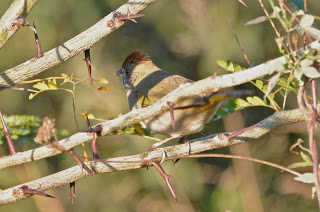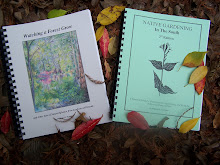Turtle Boy...kickin' butt 'n takin' names...
It would be no great exaggeration to say that Matt Conn grew up at Lafayette's Acadiana Park Nature Station. Even before I got there in 1986, Matt had already gained infamy as the star of “Turtle Boy,” naturalist Steve Shively's short film featuring eight-year-old Matt and his backyard menagerie of turtles. Thanks to his mom, Kim, Matt and sister Emily visited the Nature Station seemingly just about every week for years; and like many kids, Matt fell hard for the Wild Things. As a college student he went on to work under me as a teaching naturalist at the Nature Station before graduating from ULL with a degree in Renewable/Sustainable Resources. Today, Matt serves as Senior Ecological Project Manager for the John Chance company, a survey/environmental/regulatory firm in Lafayette.
typical "scrub-shrub" habitat bordering a live oak forest
A few years ago, Matt jumped at the chance to acquire 67-acres of freshly-mutilated live oak forest, marsh, and cypress swamp down in Iberia parish, just above Weeks Island. Since then he's planted thousands of trees and is carefully managing the recovery of that diverse little chunk of land.
the elusive/reclusive Seaside Sparrow in a salt-marsh above Sabine Pass
(photo by Matt Conn)
Matt also got into nature photography, and went straight for the most difficult of natural subjects – birds. Unlike plants or turtles, birds move around a lot, and it's exceedingly difficult to capture decent images of them. Now, Matt's wanting to learn all he can about birds; but rather than carrying around a field guide and a pair of binoculars, he just totes his camera, shoots hundreds of frames, and then identifies them later at his leisure. Recently – and much to our mutual benefit – he's been taking shortcuts and simply sending me photos of the birds whose identities he can't figure out.
Green-tailed Towhee; note lovely citrine-yellow edges to folded wing feathers
(photo by Matt Conn)
Just after dawn on 29 October, he photographed a bird at the scrubby entrance to his land that he knew was very different from the regularly-occuring species that he'd been observing. Looking through his field guide, he identified it himself: a Green-tailed Towhee; a ground/brush-dwelling, stout-billed, long-tailed, sparrow-like bird of the mountain-region of the western U.S. During the winter months, Green-tailed Towhees migrate down into the far southwestern U.S. and Mexico. The easternmost edge of the Green-tailed Towhee's wintering grounds is west-central Texas. But as birds are wont to do, a few of them always end up well outside their wintering grounds; some species more than others.
That's the thing about birds. They have wings, and those wings often carry them to wacky places. Birds that are encountered out of place are called “vagrants.”
Like all states, Louisiana keeps close track of its birds – even its vagrant birds. In fact, vagrant bird sightings are the most eagerly-anticipated of all. They're just so . . . vagrant . . . y'know? Some arid-southwestern U.S. vagrant species such as Rufous Hummingbird, Black-chinned Hummingbird, Ash-throated Flycatcher and Vermilion Flycatcher are actually regularly-occurring in Louisiana each winter, with a dozen or two (or more) annual records for each. Others like Scott's Oriole, Sage Thrasher, and the Green-tailed Towhee are recorded much more infrequently, certainly not every winter. In fact, according to Louisiana Bird Records Committee chairman Steve Cardiff, there were only 10 total records of Green-tailed Towhee on file for Louisiana prior to this winter.
Matt's Green-tailed Towhee (lodged here in a honey locust tree)
is one of four recorded thus far in Louisiana this winter
(photo by Matt Conn)
This winter is shaping up to be an odd one, weather-wise and bird-wise. It's going to be a noticeably warmer one, for starters; and with the awful devastation of food, water, and habitat resources in drought-plagued Texas, Louisiana is already receiving a number of rarely-occurring vagrants, including four Green-tailed Towhee sightings thus far. This winter's Green-tailed Towhee sightings have emanated from just south of Shreveport, just south of Alexandria, the Thornwell area of southern Jeff Davis parish, and Matt's bird in Iberia parish.












